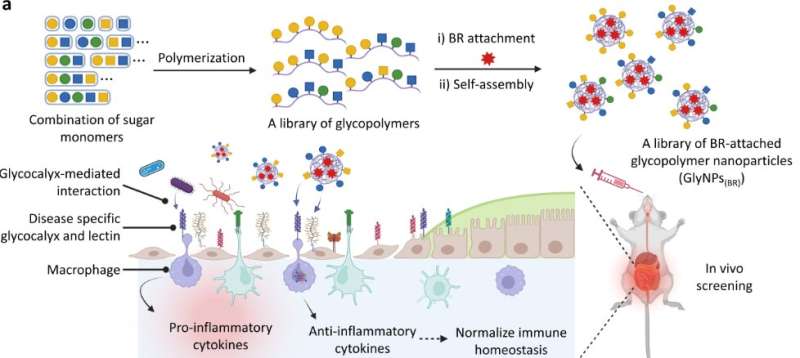This article has been reviewed according to Science X's editorial process and policies. Editors have highlighted the following attributes while ensuring the content's credibility:
fact-checked
peer-reviewed publication
trusted source
proofread
Anti-inflammatory nanoparticles mimic glycocalyx in IBD patients

Cases of chronic inflammatory bowel disease (IBD), such as Crohn's disease and ulcerative colitis, are on the rise worldwide. The benefits of current medications to treat patients with these diseases are limited by problematic side effects. In the journal Angewandte Chemie International Edition, a South Korean research team has now introduced a new method of treatment based on nanoparticles that mimic a special carbohydrate layer (glycocalyx) located on inflamed bowel cells. These particles trigger anti-inflammatory effects in the diseased sites in the intestine.
Stomach cramps and severe diarrhea, often accompanied by significant weight loss, are some of the symptoms repeatedly suffered by patients with IBD, often for weeks at a time. The causes of this condition remain unclear but seem to involve a malfunction of the immune system. A cure is not yet in sight. Current treatments aim to reduce symptoms with anti-inflammatory medications, such as 5-aminosalicylic acid (5-ASA), corticosteroids, and immunomodulators. However, their long-term use is not recommended because of their severe side effects, such as a high risk of infection resulting from immunosuppression.
A team led by Hee-Seung Lee and Sangyong Jon at the Korea Advanced Institute of Science and Technology (KAIST) has now developed an innovative approach for a medication that can be taken orally and targets the inflamed sites in the gastrointestinal tract, minimizing systemic effects.
The starting point of their approach was the glycocalyx, a carbohydrate-rich layer that coats the cells on the surface of the intestine. Beneficial gut bacteria, which have their own matching glycocalyx, attach to this coating. With diseases from the IBD family, the glycocalyx carbohydrate patterns of inflamed intestinal regions are so altered that pathogenic bacteria can attach and enter the mucous membrane.
The team therefore developed nanoparticles that mimic the glycocalyx pattern. Starting with the five sugar monomers most commonly found in nature, they produced a collection ("substance library") of different polymer chains that have one, two, three, four, or five of these sugars in random order and composition as side chains. These polymer chains aggregate into nanoparticles. They also attached bilirubin molecules. Bilirubin is a bile pigment that is an antioxidant naturally produced by the body and it has an anti-inflammatory effect.
When administered orally to mice with IBD, some versions of these nanoparticles reduced symptoms significantly better than the drug 5-ASA. Nanoparticles with mannose and N-acetylglucosamine were the most effective. These two sugars increase uptake of the nanoparticles by activated macrophages in the inflamed intestine, and bilirubin very efficiently inhibits the inflammatory activity of these immune cells. The concentration of certain inflammatory cytokines is significantly reduced, the production of anti-inflammatory factors is stimulated, and oxidative stress is reduced. The immunosuppressive effect is limited to the inflamed areas of the intestine, minimizing unfavorable systemic side effects.
More information: Dohyun Yoo et al, Anti‐inflammatory Glycocalyx‐Mimicking Nanoparticles for Colitis Treatment: Construction and In Vivo Evaluation, Angewandte Chemie International Edition (2023). DOI: 10.1002/anie.202304815




















